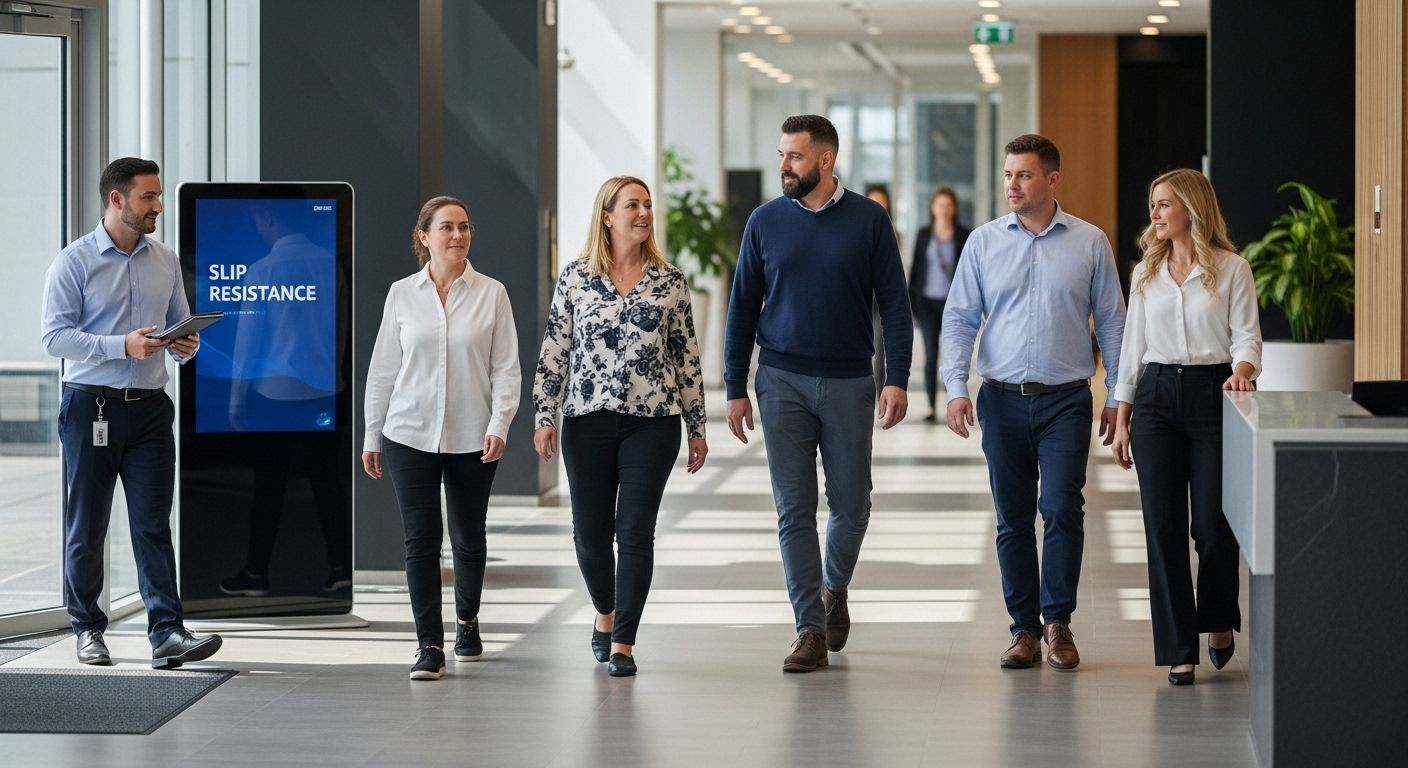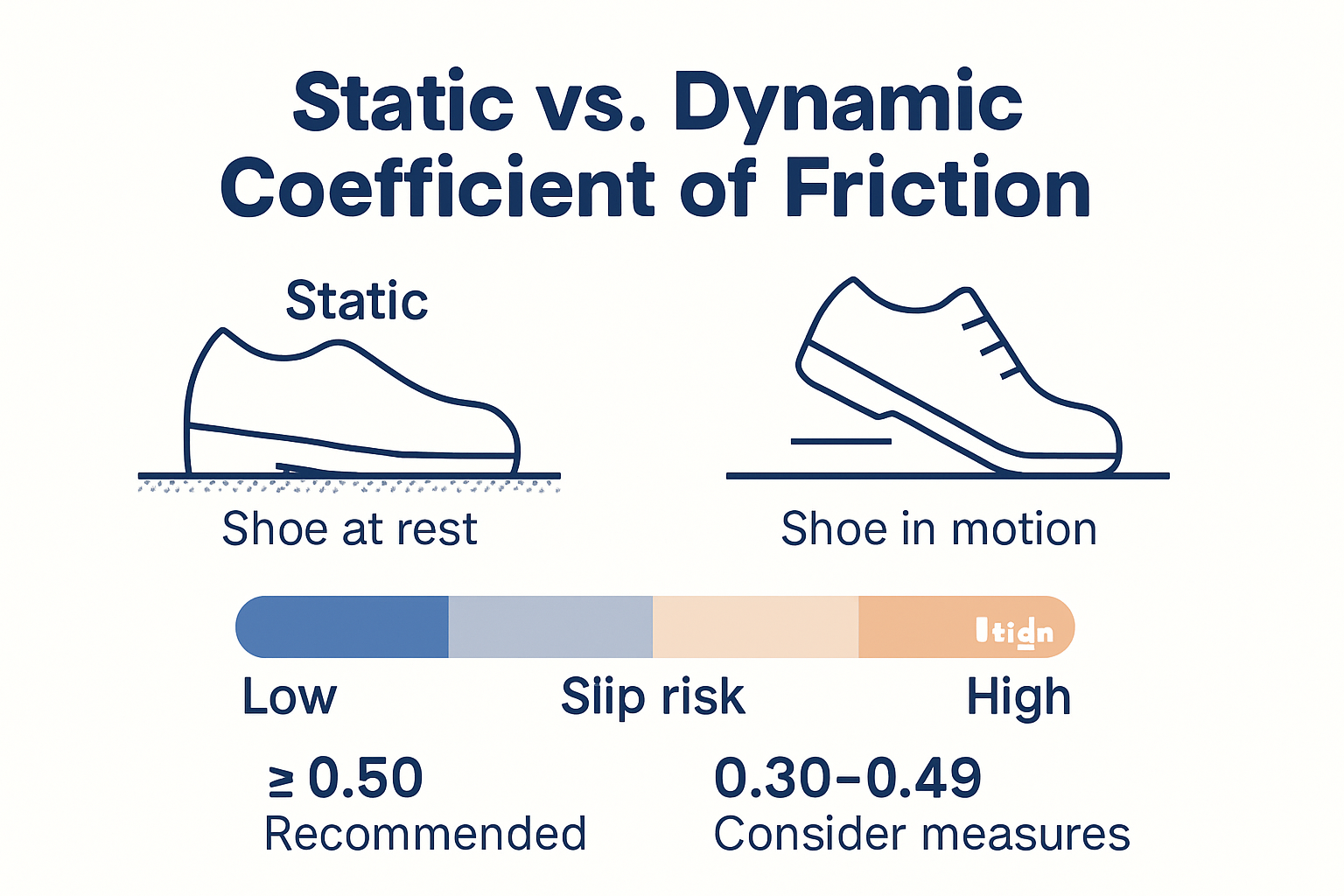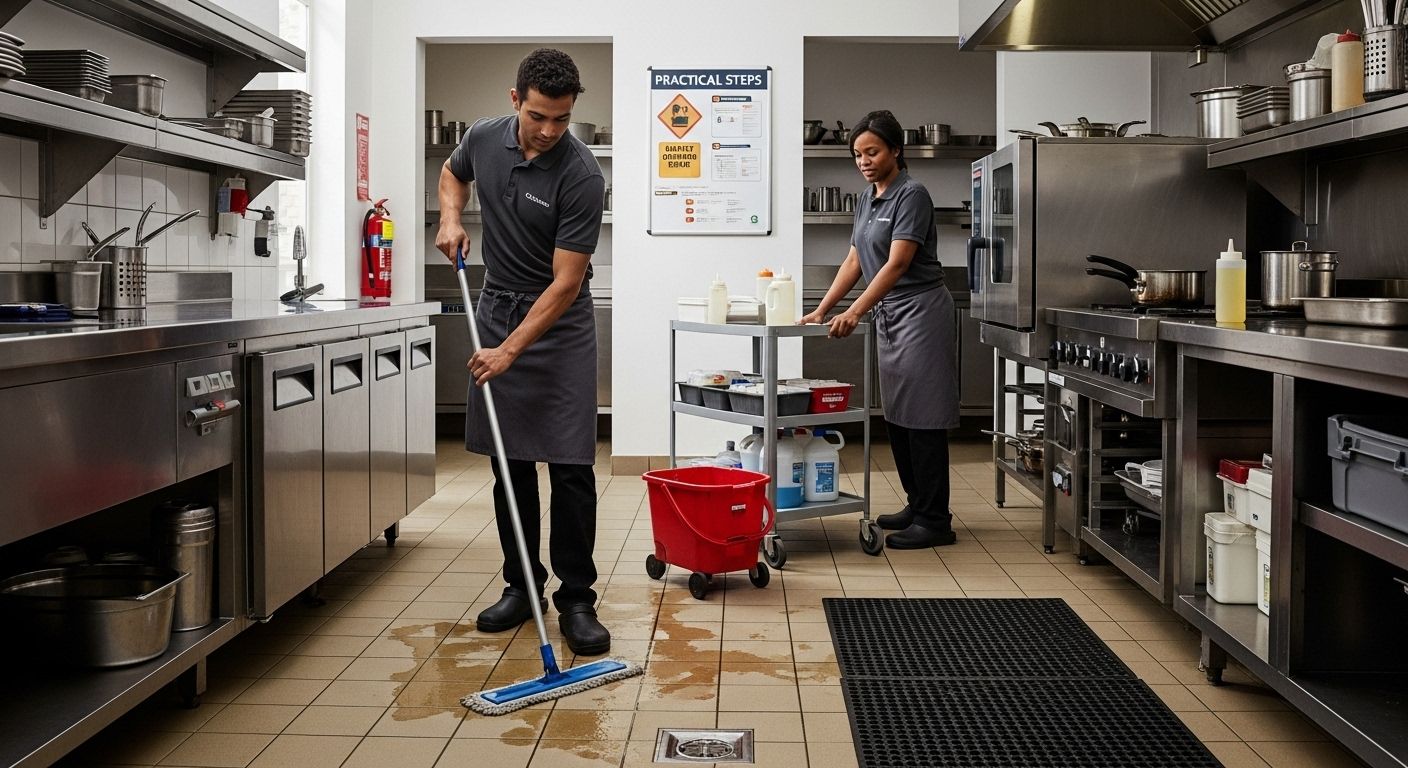
Slip resistance means a lot more than just checking the floor for spills. Every year, slips, trips, and falls cause nearly 700 workplace deaths and over 229,000 injuries in the US alone. Most people think a quick mop or warning sign will do the trick. Actually, the science and strategy behind slip resistance go way deeper—and can end up saving lives and major costs.
Table of Contents
- Understanding Slip Resistance And Its Importance
- How Slip Resistance Is Tested And Rated
- Key Factors Affecting Slip Resistance In Facilities
- Practical Steps To Improve Slip Resistance In Your Space
Quick Summary
| Takeaway | Explanation |
|---|---|
| Prioritize slip resistance for safety | Maintaining proper slip resistance is crucial to minimize workplace accidents and ensure employee safety. |
| Regularly test surfaces for slip resistance | Utilize standard testing methodologies to assess the slip resistance of walking surfaces in various conditions. |
| Implement proactive maintenance strategies | Regular cleaning, immediate spill response, and surface inspections can greatly enhance slip resistance and safety. |
| Choose appropriate flooring materials | Invest in flooring solutions with high traction properties based on the specific environment and foot traffic. |
| Train employees on slip prevention | Regular safety training and clear operational protocols help foster a culture of safety and proactive incident prevention. |
Understanding Slip Resistance and Its Importance
Slip resistance represents a critical safety measurement that determines how effectively a surface prevents unintended sliding or movement. In commercial and industrial environments, understanding what is slip resistance goes far beyond a technical specification—it’s a fundamental aspect of workplace safety and risk management.
The Science Behind Slip Resistance
At its core, slip resistance measures the friction between a walking surface and the sole of a shoe or human foot. The Centers for Disease Control and Prevention (CDC) defines slip resistance as the relative force that resists the tendency of a shoe or foot to slide along a walkway surface. This scientific measurement is typically quantified through the coefficient of friction, which indicates how much traction a surface provides under different conditions.
The coefficient of friction is determined by multiple factors, including surface texture, material composition, moisture levels, and contaminants. A higher coefficient means greater slip resistance, which translates directly to reduced risk of accidents. The Occupational Safety and Health Administration (OSHA) emphasizes that maintaining appropriate slip resistance is crucial for preventing workplace injuries.
Economic and Safety Implications
The importance of slip resistance extends far beyond theoretical safety considerations. Workplace slips, trips, and falls represent a significant economic burden for businesses. These incidents can result in:
Here is a summary table that organizes the economic and safety implications of slip resistance as discussed in the article. This makes it easier to scan the key impacts on businesses.
| Economic/Safety Impact | Description |
|---|---|
| Direct Medical Costs | Expenses related to employee injuries and treatment |
| Workers’ Compensation Claims | Potential financial liabilities for businesses |
| Productivity Losses | Time missed due to injury and potential workplace disruptions |
| Potential Legal Challenges | Liability issues arising from inadequate safety measures |
- Direct Medical Costs: Expenses related to employee injuries and treatment
- Workers’ Compensation Claims: Potential financial liabilities for businesses
- Productivity Losses: Time missed due to injury and potential workplace disruptions
- Potential Legal Challenges: Liability issues arising from inadequate safety measures
Businesses across various sectors—from manufacturing and warehousing to hospitality and healthcare—must prioritize understanding and implementing proper slip resistance strategies. This involves regular surface assessments, appropriate floor treatments, and strategic selection of flooring materials that offer optimal traction.
Effective slip resistance management requires a comprehensive approach that considers environmental conditions, foot traffic patterns, and specific workplace requirements. By proactively addressing slip resistance, organizations can create safer work environments, reduce potential accidents, and demonstrate a genuine commitment to employee well-being.
Ultimately, slip resistance is not just a technical specification but a critical component of workplace safety culture. It represents a proactive investment in protecting human capital and maintaining operational efficiency.
How Slip Resistance Is Tested and Rated
Testing and rating slip resistance involves sophisticated scientific methods designed to provide comprehensive assessments of surface safety. These evaluations go beyond simple visual inspections, utilizing precise technological approaches to measure the friction and traction characteristics of different surfaces.
Standard Testing Methodologies
The American Society for Testing and Materials (ASTM) F2913-17 provides the most widely recognized standard for measuring slip resistance. This methodology focuses on determining the dynamic coefficient of friction (DCOF), which quantifies how easily a shoe or foot might slide across a surface under specific conditions.
The testing process involves specialized equipment that simulates real-world walking scenarios. Researchers use standardized testing apparatuses that measure the force required to initiate movement across a surface. These tests consider multiple variables, including:
- Surface material composition
- Moisture and contaminant presence
- Temperature variations
- Shoe sole material characteristics
Coefficient of Friction Measurement
The International Code Council (ICC) emphasizes the importance of measuring both static and dynamic coefficients of friction. Static coefficient measures the force needed to start movement, while dynamic coefficient determines the force required to maintain movement.

Typical rating systems classify surfaces based on their coefficient of friction:
The following table summarizes the levels of slip resistance according to coefficient of friction, as well as the associated risk level mentioned in the article. This helps readers understand how surfaces are rated for safety.
| Risk Level | Coefficient of Friction (COF) |
|---|---|
| Low Risk | Below 0.40 |
| Moderate Risk | 0.40 – 0.60 |
| High Traction | Above 0.60 |
- Low Risk: Coefficient below 0.40
- Moderate Risk: Coefficient between 0.40 and 0.60
- High Traction: Coefficient above 0.60
These ratings provide businesses and facility managers with clear guidelines for assessing surface safety. However, it is crucial to understand that slip resistance is not a static characteristic. Factors such as surface wear, cleaning procedures, and environmental conditions continuously impact a surface’s slip resistance.
Professional testing involves comprehensive protocols that simulate various real-world scenarios. Technicians might introduce different contaminants like water, oil, or other substances to evaluate how surface traction changes under diverse conditions. This approach ensures a more accurate representation of potential slip hazards in actual workplace environments.
By understanding these testing methodologies, businesses can make informed decisions about flooring selections, maintenance strategies, and safety interventions. The goal is not just compliance but creating environments that proactively minimize slip-related risks for employees and visitors.
Key Factors Affecting Slip Resistance in Facilities
Slip resistance in facilities is a complex issue influenced by multiple interconnected factors that can significantly impact workplace safety. Understanding these variables is crucial for implementing effective prevention strategies and maintaining a safe working environment.
Environmental and Surface Conditions
According to Caltech’s Environmental Health and Safety department, several critical environmental factors directly impact slip resistance. Contaminants play a pivotal role in reducing surface traction. These include:
- Water and liquid spills
- Grease and oil residues
- Dust and loose particulate materials
- Cleaning solution residues
Poor drainage and inadequate floor maintenance can exacerbate these risks. The University of Tennessee’s Environmental Health & Safety department emphasizes the importance of immediate spill cleanup and regular surface maintenance to mitigate slip hazards.
Structural and Design Considerations
The Occupational Safety and Health Administration (OSHA) recommends that walking surfaces maintain a static coefficient of friction (COF) of 0.5 to ensure proper slip resistance. Structural factors that influence slip resistance include:
- Surface texture and material composition
- Floor levelness and evenness
- Presence of floor transitions or unexpected level changes
- Lighting conditions that impact visual perception of surface conditions
Additional design considerations involve selecting appropriate flooring materials for specific environments. High-traffic areas, wet zones, and industrial settings require specialized flooring solutions that provide consistent traction under varied conditions.
Human and Operational Factors
Slip resistance is not solely dependent on physical surface characteristics. Human factors and operational practices significantly contribute to workplace safety. These include:
- Employee footwear quality and condition
- Worker training on safety protocols
- Workplace culture around maintenance and cleanliness
- Use of appropriate personal protective equipment
Proactive businesses implement comprehensive strategies that address these multifaceted challenges. This might involve regular surface assessments, employee training programs, investment in high-traction flooring materials, and establishing rigorous cleaning and maintenance protocols.
By recognizing the complex interplay of environmental, structural, and human factors, organizations can develop nuanced approaches to slip resistance. The goal is not just compliance but creating a holistic safety environment that protects employees and minimizes potential accidents through systematic prevention and awareness.
Practical Steps to Improve Slip Resistance in Your Space
Improving slip resistance is a strategic process that requires a comprehensive and proactive approach. Businesses can significantly reduce slip-related risks by implementing targeted interventions that address both environmental and operational factors.
Surface Treatment and Maintenance
The Centers for Disease Control and Prevention (CDC) provides critical guidance on maintaining slip-resistant surfaces. Key strategies include:
- Regular cleaning and immediate spill removal
- Application of specialized anti-slip coatings
- Routine surface inspections for wear and damage
- Using appropriate cleaning solutions that do not compromise traction
Professional floor treatments can dramatically enhance surface grip. These may involve applying textured sealants, using specialized floor treatments that increase friction, or installing protective overlays designed to improve traction in high-traffic areas.
Strategic Mat and Flooring Solutions
The Occupational Safety and Health Administration (OSHA) recommends strategic use of mats and flooring solutions to mitigate slip hazards. Effective approaches include:
- Installing high-quality entrance mats with slip-resistant backing
- Using floor mats in areas prone to moisture or contamination
- Selecting flooring materials with inherent slip-resistant properties
- Implementing zoned flooring solutions that adapt to different environmental conditions
Mat placement is crucial. Entrances, production areas, kitchens, and other high-risk zones require carefully selected mats that can effectively trap moisture and debris while providing additional traction.
Training and Operational Protocols
Technical solutions must be complemented by robust human factors management. This involves developing comprehensive training programs and establishing clear operational protocols that prioritize slip prevention. Key components include:
- Regular safety training for employees
- Clear signage indicating potential slip hazards
- Establishing rapid response protocols for spills and surface contamination
- Providing appropriate slip-resistant footwear
- Creating a culture of safety awareness
Successful slip resistance strategies require ongoing commitment. Regular assessment, employee engagement, and willingness to adapt and improve are essential. By combining technical interventions with a proactive safety culture, businesses can create environments that minimize slip-related risks.

The ultimate goal is not just compliance but creating workspaces where safety is integrated into every aspect of operational design and employee behavior. This holistic approach transforms slip resistance from a technical requirement into a fundamental aspect of organizational culture.
Frequently Asked Questions
What is slip resistance?
Slip resistance is the measurement of a surface’s ability to prevent unintended sliding. It is crucial for ensuring the safety of walking surfaces in various environments.
How is slip resistance tested?
Slip resistance is typically tested using standardized methods, such as those provided by the ASTM F2913-17, which measures the dynamic coefficient of friction (DCOF) of a surface under specific conditions.
What factors affect slip resistance?
Key factors that affect slip resistance include environmental conditions (like moisture and contaminants), surface texture and material composition, and human factors such as footwear and employee training on safety protocols.
How can businesses improve slip resistance in their facilities?
Businesses can improve slip resistance by implementing regular cleaning and maintenance, applying specialized anti-slip coatings, using strategic mat placements, and providing employee training on slip prevention safety protocols.
Take Control of Slip Resistance With Expert Mat Solutions
Have you read about the real dangers and hidden costs that inadequate slip resistance can create in your workspace? From unpredictable spills to high-traffic floors and risky wet areas, reducing slip-and-fall incidents is not just about quick fixes. As highlighted in the guide, long-term safety starts with choosing the right flooring and regularly addressing risk through tested solutions.
If you are concerned about employee injuries, unexpected downtime, or legal liabilities, it is time to act. Discover the power of professionally designed commercial mats that provide consistent traction and absorb moisture before it reaches critical walkways. At Mats4U.com, you will find a wide selection of Waterhog, Rubber, and custom matting products engineered for the demands of industrial and commercial settings. Browse our full collection, learn how specialized entrance and safety mats address the exact slip resistance challenges outlined in the article, and experience the peace of mind our durable commercial mats can deliver. Protect your team and your business—visit Mats4U.com today and start building a safer environment without delay.







